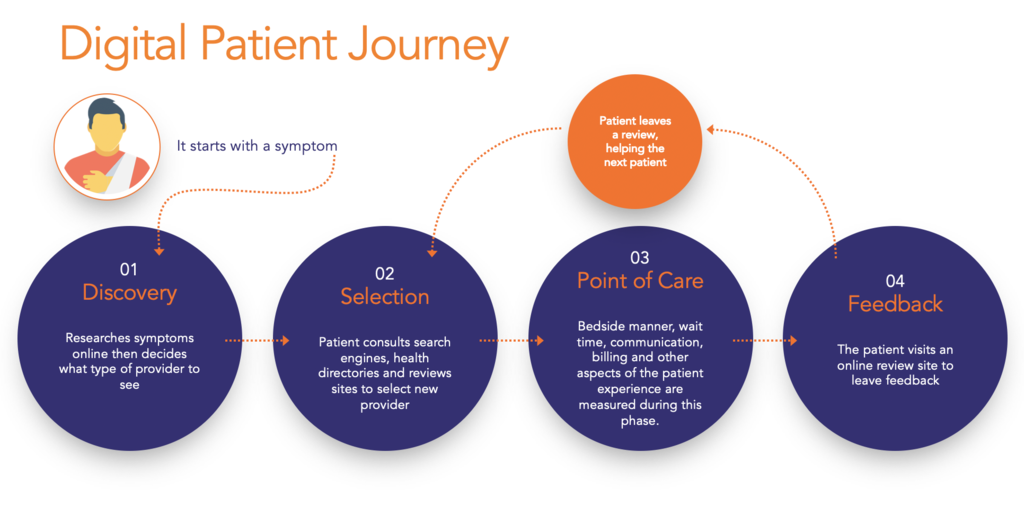Putting Your Customers at the Center of Your Brand Proposition Leads to a Happy Union
// By Lisa D. Ellis //
With a large and growing percentage of people turning to the internet to research their health care options, what your customers say about you publicly can be the deciding factor in whom new patients ultimately choose. This makes it essential to put customers at the center of your efforts to ensure they have a positive experience that they want to share with others.
For better or worse, in 2019, most organizations find that their online reviews have a profound influence on patient choice of a physician. In practical terms, this means you need to stay on top of exactly what people are saying online about your providers and facilities. This will allow you to respond to their compliments and criticisms effectively.

Chris Boyer, director of digital marketing strategy and analytics at University of Minnesota Health/Fairview Health Services
This advice comes from Chris Boyer, director of digital marketing strategy and analytics at University of Minnesota Health/Fairview Health Services in Minneapolis, Minnesota (recently renamed M Health Fairview), and Aaron Clifford, senior vice president of marketing at Binary Fountain, an online reputation management platform.
The Changing Scope of Brand
Boyer, Clifford, and Dennis Jolley, vice president of institutional advancement at Gillette Children’s Specialty Healthcare in St. Paul, Minnesota presented at Greystone’s 2018 Healthcare Internet Conference to discuss the evolution of brand in today’s competitive landscape.
Boyer points out that in this age of consumerism, marketing efforts need to be framed around the patient journey. To do this, he stresses that the consumer must be at the center of digital planning efforts. This takes a shift in thinking, moving out of the organization-centric mindset to think like a patient and focus on the things patients care about.
For most people, Boyer says that one of the most compelling factors in making a decision of where to seek care ties back to other patients’ experiences. This is consistent when you realize that customers look to reviews when shopping for goods such as appliances, sneakers, and fitness wear. The same is true of health practices.
To help M Health Fairview see its digital efforts through the eyes of consumers, Boyer and his team mapped the organization’s digital channels to every stage of the patient journey, starting from the awareness phase all the way through to the loyalty stage. By aligning the tools and tactics to these consumer stages, the team can develop strategies to address these “micro-moments.”

Using Digital to Follow the Online Patient Journey
For instance, when people are looking for a cardiologist in their community (in the awareness phase), they will likely do a variety of searches online to research all of the reviews about the providers they are considering. It’s important to view online reviews as a way to address consumer needs at this stage of a journey, and a positive review from a patient can help promote awareness of the health system’s service more effectively than, perhaps, advertising.
Once someone selects a provider, the journey is far from over. Often the person will revisit reviews of this provider again to reinforce the decision, or to compare a few options.
After setting an appointment with the provider, the person will likely go online once more to get directions and find out how to prepare for the visit. This provides yet another opportunity to read the reviews posted on popular websites.
Following the appointment, the patient will be likely to leave his or her own review about the experience (particularly if it’s either really good or really bad). This patient’s own review will then inform future patients — and in the case of a bad review, will perhaps turn people to your competitor.
Boyer suggests that focusing on all of these touchpoints and how they help address questions and needs through the digital journey will not only help strengthen each individual tactic, but when expanded to include all digital elements, will create a “closed loop ecosystem, with everything coming full circle.”
Using Reviews to Educate Health Systems

Aaron Clifford, senior vice president of marketing, Binary Fountain
Patient reviews don’t only educate perspective patients, though. They can also provide a wealth of insight for health systems and providers.
“But it’s important for health systems and physicians to understand what is really being said,” Clifford cautions, or else they may make changes that don’t address the actual problem. “For instance, physicians may have gotten a one-star rating, but it could have nothing to do with the quality of care provided or the physician’s bedside manner,” he says. Rather, it could be that someone working at the front desk was rude, that parking was difficult, or that the cleanliness of the facility was not acceptable.
By analyzing and understanding the patient journey to know what factors a person is reacting to, you can perform appropriate service recovery, he says.
Responding to Negative Reviews
For negative reviews, damage control must be done. “When patients are unhappy, we want to facilitate the conversation offline and give them a number to call and do service recovery,” Clifford points out. He also stresses that the way you respond to a review can be as telling as the review itself. As Boyer puts it, “Your response tells a consumer, when he or she is making a choice to go to a health system or doctor, that the provider cares.”
In the ideal situation, once the situation is addressed, the customer will go back online and explain how their concern was resolved.
“We are dealing with consumers, patients, family members. Showing that you care by responding makes a big difference from a brand perspective — and for being good humans, too,” he says.
Recognizing Positive Reviews
It’s also important to acknowledge the positive reviews.
“At my health system, we take a positive review about a specific provider or location and share it with the staff to recognize their efforts,” Boyer says.
This can go a long way toward reinforcing what your system is getting right, and lets people know their work is appreciated.
“We know physician burnout is a big issue. When you have a way to share kudos, it makes a difference,” Clifford says. “We have clients who receive positive first-party and third-party reviews from patients that mention names of nurses and doctors. It’s good for people to see they are mentioned, and they care.”
Sharing reviews with staff members also provides a level of transparency that can be valuable. “It makes the staff aware that the voice of the customer has a really good platform and it reminds the medical and support staff to do their best so people will refer your practice to their family, friends, and everyone they reach through online reviews sites,” Clifford adds.
